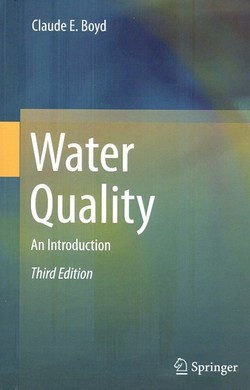
Water Quality
By
Claude E. Boyd
Preface
Water is commonplace; two-thirds of the earth is covered by the ocean, and nearly 4% of the global land mass is inundated permanently with water. Water exists in the hydrosphere in a continuous cycle—it is evaporated from the surface of the earth but subsequently condenses in the atmosphere and returns as liquid water. Life in all forms depends on water, and fortunately the earth is not going to run out of water; there is as much as there ever was or is ever going to be.
Despite the rosy scenario expressed above, water can be and often is in short supply, a trend that will intensify as global population increases. This results because all places on the earth's land mass are not equally watered. Some places are well watered, others have little water, and water may be deficient in well- watered locations during droughts. The quality of water also varies from place to place and time to time. Most of the earth's water is too saline for most human uses, and pollution from anthropogenic sources has degraded the quality of much freshwater and lessened its usefulness. Evaporation is a water purification process, but salts and pollutants left behind when water evaporates remain to contaminate the returning rainwater.
As the human population has grown, the necessity for producing goods and services necessary or desired by the population has increased, resulting in greater water use and water pollution. Water quality has increased in importance, because the quantity of water often cannot be assessed independently of its quality. Water quality is a critical consideration in domestic, agricultural, and industrial water supply, fisheries and aquaculture production, aquatic recreation, and the health of ecosystems. Professionals in many disciplines should understand the factors controlling concentrations of water quality variables as well as the effects of water quality on ecosystems and humans. Efficient management of water resources requires the application of knowledge about water quality.
Water quality is a complex subject, and unfortunately, the teaching of this important topic is not well organized. In many colleges and universities, water quality instruction is given mainly in certain engineering curricula. The classes emphasize specific aspects of water quality management and tend to focus on the treatment of water for municipal and domestic use and on the methods of improving effluent quality to lessen pollution loads to natural water bodies. Such classes typically have prerequisites that prohibit students from other disciplines from enrolling in them. Specific aspects of water quality are taught in certain courses in the curricula of agriculture, forestry, fisheries and aquaculture, biology, chemistry, physics, geology, environmental science, nutrition, and science education. But, the coverage of water quality in such courses does not provide an understanding of water quality as a whole.
When I began teaching water quality in the College of Agriculture at Auburn University in 1971, available texts on water quality, limnology, and water chemistry were unsuitable for the class. These books were either too descriptive to be mean- ingful or too complicated to be understood by most students. Students who need training in water quality often have a limited background in physics and chemistry. As a result, the background for each facet of water quality should be provided using only first year college-level chemistry, physics, and algebra. The book Water Quality: An Introduction was based on lectures for the class. This book is slanted toward physical and chemical aspects of water quality, but it includes discussions of interactions among physical and chemical variables and biological components in water bodies. Because the chemistry is presented at a basic level, some calculations explanations, and solutions to problems are approximate. Nevertheless, simplification allows students to grasp salient points with relatively little "weeping, wailing, and gnashing of the teeth." Hopefully, this third edition of Water Quality: An Introduction is an improvement over previous editions. The preparation of this book would not have been impossible without the excellent assistance of June Burns in typing the manuscript and proofing the tables references, and examples.
Contents
1 – Physical Properties of Water.
2 – Solar Radiation and Water Temperature.
3 – An Overview of Hydrology and Water Supply.
4 – Solubility and Chemical Equilibrium.
5 – Dissolved Solids.
6 – Suspended Solids, Color, Turbidity, and Light.
7 – Dissolved Oxygen and Other Gases.
8 – Redox Potential.
9 – Carbon Dioxide, pH, and Alkalinity.
10 – Total Hardness.
11 – Acidity.
12 – Microorganisms and Water Quality.
13 – Nitrogen.
14 – Phosphorus.
15 – Eutrophication.
16 – Sulfur.
17 – Micronutrients and Other Trace Elements.
18 – Water Quality Protection.



ساحة النقاش